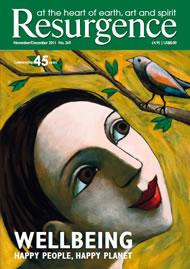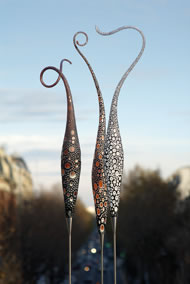There’s no denying that we are in part children of the 1960s. Me a bit older, Monica a bit younger. The currents of that time penetrated our DNA. Slowly for me, faster for Monica. I had a degree in political science and history, but spent the first 10 years of my professional life deeply engaged working for Outward Bound and related programmes in the US: learning by doing, and exploring the dynamics of responsibility, cooperation and meaningful survival in the beauty of assorted wilderness environments.
Monica ran away from home at 16 and worked on a kibbutz in Israel, returning three years later to Switzerland, where she had grown up, to do a traditional four-year apprenticeship in scientific glassblowing (lampworking). Afterwards she set up her own studio in Bern.
By coincidence (or not) both of us – me coming from New York, Monica from Bern – decided to journey to Sweden in 1979 to enrol in the little glass factory school at the wonderful and prestigious Orrefors Glassworks in Småland, nestled in the vast and forested ‘Glass Kingdom’ of that country. Three years of paradise ensued, living on a small farm taking care of semi-domesticated wild pigs by way of rent, and blowing glass six days a week. I found the farm. She arrived with a car. A marriage made in heaven.
Why glass? I was 31 years old when we took up this choice. But switching from lampworking to blown, hot molten glass nevertheless implied a major shift in material and process and an ensuing difficulty of technical mastery. I would say that the choice was pure intuition, not unlike the intuition of acquiring a dog as a pet, whereby you suddenly know that’s the one for you. Or, on a loftier level, falling in love, and just knowing your partner is the one for you. In art, these things are similar. A material, a métier, a way of working and being: all these things are implied, and they work better when they are wisely, albeit intuitively, aligned with one’s innate character. The attraction of materials, animals, people and techniques for artistic expression (and thinking) are all intimately connected.
In Sweden we were blessed to work as assistants to the former Orrefors master Wilke Adolfsson, who was working in partnership with Ann Wolff, the renowned artist and designer from Kosta, another of the great Swedish factories. It was just two and a half years, but it was total immersion. Ann opened up a universe of colours and shapes, and Wilke the clear lines of form and the crucial details of craftsmanship. Ours was definitely a Zen and the Art of Motorcycle Maintenance moment: a complete submersion in the critical pre-eminence of detail, and paying attention to each one. More than that there was a fabulous integration of mind, matter, and body – a way of working that blended one’s being in fullness with core materials of Mother Earth herself. An artistic and scientific commingling, which to this day gives us the greatest joy.
We would bicycle into the village in the morning to join Wilke for the drive to Kosta and the glassblowing studio. One morning, very early, we stopped for a badly needed tank of fuel. The automated pump at the unattended garage swallowed Wilke’s 20 krona note, but without offering any fuel in return. Wilke paced, reflected, and worried that pump with contemplation. Finally, by means of a credit card and a straightened-out paperclip, he managed to penetrate the mouth of the machine – and it rewarded him by disgorging the note as well as allowing us the crucial liquid we needed to continue our journey! It was a lesson that has been fundamental to everything we have done since, helping us to surmount endless conundrums and impenetrable barriers. It’s a story about attitude, and detail, and – yes – a pinch of dogged wilfulness.
We spent the next 20 years in the French part of Switzerland, in a small village of just 60 souls overlooking the beautiful Jura Mountains, which form part of the border with France. Our studio was a source of livelihood, as well as an incubator of evolving ideas and possibilities. For a long time we were largely satisfied with the meditation of repetition: wine glasses, bowls, plates, pitchers, vases, candlesticks – all the arts de la table. We seemed to have a knack for design and soon found ourselves designing for Rosenthal in Germany, Steuben in the US and, much later, Venini in Italy.
Bit by bit over those 20 years our ouevre morphed from production studio glass (as it is commonly referred to) to more individual and creatively original objects. Finally we came to sculpture, and ultimately only sculpture, but always retaining a deep resonance with applied art, design, and the magic of classical forms.
Our move to Paris a decade ago was rather shocking. After two decades of building up a clientele and a faithful local following, generating easily half our revenue, we simply walked away. It was a personal and impulsive move, with no practical basis to explain it. But here we are, and here we remain for now.
Recounting this trajectory helps to elucidate the images that accompany this article. Our newest work, centred around the theme of boats and their cargoes of amphoras, is a culmination of all the years that we have worked together, affording us the chance to express our own personal journey as well as that of the larger world as we see it.
There is a countervailing reality to all these charming tales, and we all know them. The 15 minutes of magical ‘aha!’ moments, drawing on the backs of envelopes whilst riding on a train, or at 2 o’clock in the morning when you can’t sleep, or during a simple dialogue in a restaurant, are countered by months and months of hard labour to actually realise some of these ideas. That’s not bad: it’s a joy, and inspiring too. But then there is the need to sell, to peddle the wares, to pay the piper. There are people who thrive at such activities, and there are people who are hopeless therein. We are solidly camped with the latter.
The new sculptures with boats and amphoras come closest to being autobiographical and personal. We are migratory creatures; the history of our species is about journeys, departures, leaving and arriving, starting over. And none more so than ourselves. Our new work is both culturally and personally inclined: an autobiographical touch inside a civilisational reflection.
Wherever humans go they build, laying down cultural lines that gradually transform into relics and artifacts over time’s inevitable march. Urban landscapes and complex designs grow and expand, deteriorate and decay. And on again we move, taking with us the memories of our exploits to use in the next story. Grain, seeds, wine, oil, gold, silver, pots and jugs, the ballast of our millennia-old civilisations transported down through the ages, and with them the stories themselves, the wandering of peoples all across this magnificent planetary landscape. People just like us. Seeking, questing, looking for new horizons, and carrying their culture, their history and their stories on their backs, in carts, and in boats.
It’s our story. It’s humankind’s story.
For more information: www.bgnonfoux.com








